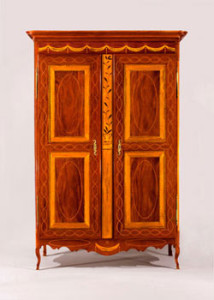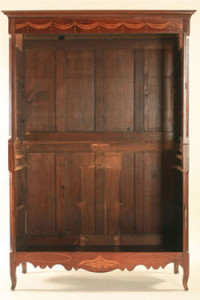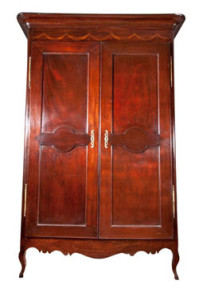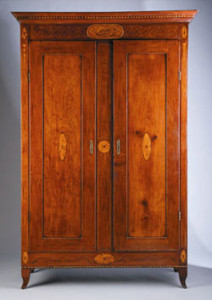‘Case’ History: A Louisiana Creole Armoire at Colonial Williamsburg

Carried away by “an inundation of Yankee furniture,” New Orleans cabinetmaker Thomas P. Willard announced in an Orleans Gazette advertisement of June 7, 1820, that he had “landed in the wooden country in the Parish of St. Helena where he can make the article of Bedsteads as cheap as the Yankees, and much more adapted to the taste of the Louisianians” (fig. 1). Willard’s notice reflects early mythologizing of an opportunistic Yankee versus genteel Southern Cavalier or aristocratic planter. (A history existed by the Civil War era that the North had been settled by Puritan Roundheads and the South by English Cavaliers, speaking to an English-inspired cultural divide.) Willard’s ad further points to the dramatic increase in imported northeastern goods to the port of New Orleans following the Louisiana Purchase (1803) and simultaneously highlights a contemporary demand for furniture specifically appealing to local taste. As one might infer from Willard’s exasperation with the flood of “Yankee” goods, some surviving Louisiana-made furniture of his era evinces northeastern influence.
Early fine furniture of the Deep South is just beginning to be discovered and appreciated by American historians for its relationship to social and political history. In spring 2009, sixty years after Joseph Downs, American Wing curator at the Metropolitan Museum of Art, quipped that “little of artistic merit was made south of Baltimore,” in his lecture Regional Characteristics in American Furniture, the Colonial Williamsburg Foundation announced its savvy acquisition of an unmatched Louisiana Creole inlaid mahogany armoire, ca. 1810-30 (fig. 2). “Creole,” from the Latin verb creare (to breed), derives from the Spanish criollo or more directly from the Portuguese crioulo, meaning native to locality; as an adjective it generally refers to people or products native to the New World or to people of Old World parentage, and much later to those of mixed African and European origins. The term also applies to aspects of material culture, including architecture and crafts. The intermingling of stylistic influences apparent in objects like this armoire has given rise to the newly defined “Creole style,” reflecting a fusion of French, French Canadian, West Indian, African, and Anglo-American aesthetic tastes.

This cabriole-leg armoire was likely constructed for a wealthy planter or merchant by a French émigré or by one of thousands of Saint-Domingue (present-day Haiti) refugees who arrived from Cuba in the wake of the Haitian Revolution (1791-1804). Between 1791 and 1812, following the revolution, the number of émigrés arriving in New Orleans from Saint-Domingue surpassed 15,000. Several thousand more lighted on Baltimore, Philadelphia, Norfolk and New York. Surviving New Orleans indenture contracts show that Saint-Dominguans frequently entered the cabinetmaking trade. Made to furnish a stately Vieux Carré (or French Quarter) townhouse or outlying plantation manse, the armoire, crafted after French models, evokes Louisiana’s Gallic heritage. Heavily decorated with typical American Federal inlay patterns (including a neoclassical urn), this cabinet underscores an old guard French Creole populace’s well-documented resistance—if gradual acquiescence—to the rapid phase of Americanization following the Louisiana Purchase. For example, American eighteenth- and early nineteenth-century furniture crafted outside of Louisiana is often “inlaid” (as opposed to painted or carved), meaning that pieces of contrasting wood or other material are set into its surfaces to form decorative patterns. In Louisiana, most furniture remained unembellished and the appearance of fashionable neoclassical designs on locally made armoires heralded an influx of Anglo-Americans and imports.

Discovered in a Natchez, Mississippi, antiques store in the 1970s, Williamsburg’s armoire remained in a private collection until recently placed on museum display. Elegantly poised on traditional French carved pieds de biche (deer feet), it stands apart from any other known wardrobe (or clothes press)—painted, inlaid, or carved—crafted in this country during the Federal era. In comparison with the many that have been documented in and around New Orleans, its façade is far more extravagant, with lively patterns that scarcely permit the eye to rest. The frieze is festooned clear across with seven inlaid three-tiered swags with dainty checkered string bows suspending bellflower tassels. The doors’ figured mahogany surfaces bear four fictive panels defined by satinwood borders and barber-pole banding, all surrounded with a guilloche pattern of treble stringing. A center or “false” stile (door divider) is decorated above with a serpent-handled urn from which erupts a leafy vine with red berries; below is an elegant inlaid strapwork pattern calling to mind eighteenth-century fretwork. (These stile inlays are incongruous in appearance with other patterning on the piece, as well as on other Louisiana examples. This may indicate the use of stock inlay on the rest of the piece with an original pattern devised for the stile.) Canted stiles are inlaid with acanthus leaves and stringing. Finally, original brass fiche or “French” hinges allow the doors to open fully, revealing an interior belt of drawers whose skirt echoes the external apron.
While nothing is known of its history prior to its twentieth-century life, it is probable that the cabinet was crafted in the Vieux Carré, where dozens of cabinetmakers produced related pieces in the first few decades after the Purchase. While noted in the extensive armoire catalogue of the new regional study, Furnishing Louisiana: Creole and Acadian Furniture, 1735-1835, it has remained unexamined in any methodical way. It challenges us to peer more closely, re-considering not only details of inlay and construction, but the cabinet’s relationship to its counterparts. What might it teach us about the history, local use, and craftsmanship of such cabinets?

Armoires have been in use since antiquity. The word armoire is derived from the Latin word armarium, meaning a place for storing arms. The related terms armoire, armarie, aumaire, and almaire all abound in French literary references, many of which are listed in the entry on the topic in Henry Havard’s classic tome, Dictionnaire de L’Ameublement et de la decoration, Vol. 1. One of the earliest depictions appears in a Ravenna mosaic at the Mausoleum of Galla Placidia (425-450 CE) (fig. 3). A mosaic lunette shows the Roman martyr St. Lawrence near a flaming gridiron. Nearby stands a cabinet, its doors open to reveal the Gospels resting on shelves within.
One may still hear such wardrobes called “armers” in the Deep South, where they were ubiquitous in an era before built-in closets and pantries became de rigeur. An ad in the New Orleans Louisiana Advertiser of December 6, 1827, for “Bedsteads, Armours, &c.—Received per brig Ivory Lord, an invoice of high-post Bedsteads, Armours, &c. for sale by C.D. Jordan, 35 Gravier street” seems to confirm the duration of such regional pronunciation as well as the importation of these objects from the northeast (fig. 4). The similarity of the word “Armours” to amour humorously reminds us of countless dramas in which hapless lovers are forced to hide inside such cabinets, a scene captured by Jean-Honore Fragonard in his print L’Armoire of 1778 (fig. 5).

For example, Louis Aragon’s Surrealist play L’Armoire à glace un beau soir (“The mirrored armoire one fine evening,” 1923), takes an armoire as its focal point and begins with a husband Jules returning home to find his wife Lénore guarding a wardrobe. The play takes as its main action the escalating conflict between the couple over the hidden contents of the armoire, presented as a metaphor for female and domestic interiority. In his analysis of Aragon’s play, Gray Read calls the armoire “a ridiculous object, an errant house within the house that modern architects tried to eliminate by designing built-in closets integral to the wall.” While Aragon’s modern play points to his central prop’s anachronistic qualities, the cabinet remains a classic feature in a timeless drama of illicit love. More traditionally, armoires are associated with marriage and the establishment of household. In keeping with European custom, the friezes of Louisiana armoires are occasionally inlaid with ciphers that personalize them. Such monograms, as well as other pictorial patterns, sometimes derive directly from silver engraving books of the period.

In the 1930s and 1940s, before their historic value was generally recognized, antique Louisiana armoires could be purchased for as little as forty dollars. Sparked in part by the Colonial Revival that was so popular at the turn of the twentieth century, interest in such artifacts gained ascendance among collectors and scholars throughout the United States. Today the appearance on the market of an inlaid Louisiana armoire is quite rare. A catalogue of extant examples would include the finely preserved cabinets featured in various private and museum collections. Ideally, it would include others that are often overlooked by scholars, cabinets in poor condition or that have been the object of heavy restoration. Even if not worthy of exhibition, such careworn pieces have scholarly value. Under careful examination by experts, they reveal clues that support the research of our most well-preserved and sophisticated surviving period furniture. For example, while for many decades the Williamsburg armoire was unconnected with other examples, it may now be confirmed to have siblings from the same workshop. Since the related examples are not fully intact, they went unrecognized until the preparation of this article.
First, at Destrehan Plantation, originally established on the Mississippi’s winding River Road in the eighteenth century, there remains an armoire bearing a frieze that precisely matches that of the Williamsburg cabinet (fig. 6). The inlay treatment was clearly produced by the same hand, though perhaps the craftsman used a stock pattern. Seven swags (six three-lobed swags with half-patterns at either end) embellish the frieze. Though some of this armoire is replaced, including the doors and cornice, the back panel is original and its vertical members bear beaded edges.
A second related cherry armoire in a private collection bears a frieze of the same swag treatment and the back’s vertical members have beaded edges, too (fig. 7). The apron of this armoire bears an inlaid acanthus flanked by oval-shaped stringing patterns echoing the Williamsburg apron. Highly refined legs on all three bear the same profile. These details exemplify how specific modes of construction used by craftsmen in particular workshops help us to link their works together. By grouping the details of frieze inlays, legs, and beaded edges, we can safely attribute the three aforementioned armoires or “Williamsburg group” to the same shop.

To date, only one other piece is known to have a similar inlay pattern: a Creole headboard now in the New Orleans Museum of Art (fig. 8). Bearing a single swag at its center, its arched crest echoes Spanish baroque cathedral facades found in colonial Mexico. Together with its Anglo-American inlay, it speaks to the amalgamation of cultural influences in the Lower Mississippi River Valley.
Until the three objects surfaced, the Williamsburg armoire stood alone. It had been loosely associated with the so-called “Butterfly Man” group, consisting of about twenty-six known armoires, of which eleven are inlaid. (This anonymous craftsman’s cabinets are named for the consistent appearance of a butterfly or “flying Dutchman” interior patch, applied to reinforce the glue joints of the side panels.) The identity of the Butterfly Man is a mystery, yet at least one local inlay maker, George Dewhurst of 29 Bourbon Street, would have been well-versed in Anglo-American patterns from Boston to Lexington, Kentucky, to Baltimore, places he lived as he migrated south.
All of the Butterfly Man armoires strongly resemble one made for Stephen Girard (1750-1831) of Philadelphia in 1796 by Saint-Domingue émigrés Jean-Baptiste Laurent and Charles Domballe, suggesting that the Butterfly Man hailed from Saint-Domingue, too (fig. 9). Girard, Philadelphia’s most prominent trader, was a merchant, banker, and philanthropist and one of the four wealthiest Americans at the time of his death. He bankrolled the War of 1812 and financed the first national bank in Philadelphia, then the capital. That the Laurent-Domballe armoire was made for him for a payment of eighty dollars provides only a slight hint of his involvement in the Saint-Domingue economy and extensive network of cargo ships moving goods among ports at Bordeaux, New York, New Orleans, Cap-Français, and Havana. Girard’s household collection, still largely intact, remains on display at Girard College, which he founded, and includes china from Canton and Nanking where he also traded.

The similarity of the Butterfly Man’s handiwork and the Williamsburg group to that of Laurent and Domballe’s work is unsurprising. Importantly, the Williamsburg armoire is distinguished from the Butterfly group by particular construction details: a different cornice profile, more attenuated legs (minus a notch at the knee), and the lack of the characteristic butterfly-shaped patches on the interior walls. Further, the Williamsburg group’s inlaid swags are three-tiered and the Butterfly Man group bears two-tiered examples. Finally, profuse and detailed inlay patterns, including the serpent-handled urn, differentiate the Williamsburg armoire from the Butterfly group, which is decorated with more restraint.
Regardless of who the inlay maker was, the cases of the Butterfly Man and Williamsburg group were probably crafted by one of the manygens de couleur libres (“free men of color,” the descendants of free Africans and mixed peoples) who practiced cabinetmaking in New Orleans. While no invoices survive, a rare Courrier de la Louisiane advertisement placed by cabinetmaker Philippe August in August 1808 offers for sale his entire inventory of mahogany and cherry wood furniture including 16 clothes presses (armoires) and a number of bedsteads and tables (fig. 10). In addition, August sold one lot of cherry wood and his chest of carpenter’s tools, including saws, benches, a holdfast, a turner’s wheel, and, importantly, inlay-related materials. Identified in the local notary Narcisse Broutin’s act of August 1808 as “un homme de couleur libre,” August may have been one of the considerable influx of Saint-Domingue émigrés of mixed racial parentage. While there is no firm link between August and the objects discussed here, his advertisement presents a tantalizing possibility.
It is worthwhile to consider the Williamsburg armoire as a foil to a more provincial cherry and cypress cabinet (ca. 1815) long part of a Louisiana collection. It is also exuberantly inlaid though less sophisticated in execution overall (fig. 11). A rustic version of Colonial Williamsburg’s “high-style” Creole armoire, it may represent the work of one of the many Anglo immigrants (les Americains) to Louisiana. For example, the War of 1812 brought a contingent of troops from Kentucky (“Kaintucks”), some of whom remained in New Orleans and entered various trades; cabinetmakers would have replicated what they discovered in local woodworking in their own style. If it was crafted elsewhere, Louisiana French influence seems apparent.
Recessed-panel doors are dramatically outlined in barber-pole inlay. Eight paterae punctuate the stiles, skirt, and false stile. Intriguingly, the frieze consisting of an elaborate strapwork pattern is interrupted by a later addition of a wooden roundel, which stands proud of the armoire’s surface. Inlaid into its surface is a leafy vine, as well as a calligraphic flourish in the center, perhaps meant to be a cipher. The leafy vine visible in the roundel at top is also inlaid into the apron. It is probable that both the roundel and its matching decoration on the skirt were later additions, perhaps meant to satisfy the purposes of a subsequent owner who wished to add ornament or to personalize the previously owned object. It is worthwhile to consider that patterns of ownership led to alterations in embellishment, adding to an object’s rich texture and historical resonance.
A bespoke piece, Colonial Williamsburg’s Louisiana Creole armoire represents the zenith of Louisiana antebellum craftsmanship, itself supported by a booming economy of sugar cane and cotton production. New Orleans’ tri-caste racial society of whites and Creoles, free people of color, and slaves, together with transplanted “Yankee” craftsmen, all contributed in various ways to its genesis. Careful detective work in surviving plantation homes and private collections has revealed two related cabinets, newly establishing the Williamsburg armoire as part of a yet unidentified workshop’s series. Divested of contents for permanent exhibition, this cabinet still opens to reveal salient details of construction that enlarge our understanding of its origin, production, and use.
Further reading
For detailed discussion about the polarities between Creoles and Americans see Arnold R. Hirsch and Joseph Lodgson. Creole New Orleans, Race and Americanization (Baton Rouge, 1992). Related terminology is defined in Jay Dearborn Edwards and Nicolas Kariouk Pecquet du Bellay de Verton, A Creole Lexicon: Architecture, Landscape, People (Baton Rouge, 2004). See also Rolph Trouillot and Thomas Fiehrer, eds. Who/What is Creole? especially “Culture on the Edges: Creolization in the Plantation Context” (New York, 1999): 8-28; See also Ritchie Devon Watson, Jr., Normans and Saxons: Southern Race Mythology and the Intellectual History of the American Civil War (Baton Rouge, 2008); Karen L. Cox, Dreaming of Dixie: How the South Was Created in American Popular Culture (Chapel Hill, N.C., 2011); William R. Taylor, “Cavalier and Yankee: Synthetic Stereotypes” in Myth and Southern History, Vol. 1: The Old South, Patrick Gerster and Nicholas Cords, eds. (Champaign, Ill., 1989): 133-144; Allison Burkette, “The Lion, the Witch, and the Armoire: Lexical Variation in Case Furniture Terms,” Interdisciplinary Science Reviews, Vol. 33 (2007): 315-339.
Recent works about Louisiana furniture include Jack D. Holden, H. Parrott Bacot & Cybèle T. Gontar with Brian J. Costello and Francis J. Puig, Furnishing Louisiana: Creole and Acadian Furniture, 1735-1835 (New Orleans, 2010); Cybèle T. Gontar, “The Butterfly Man of New Orleans: A Rare Group of Creole Style Armoires Identified.” The Magazine Antiques 173:5 (May 2008): 136-145; Cybèle T. Gontar “Furniture Collecting in Louisiana.” Antiques and Fine Art (Summer 2010): 206-213; Gontar, “The Campeche Chair in the Metropolitan Museum of Art,” Metropolitan Museum Journal, 38 (2003): 183-212; Gontar, “Spanish Chairs in the New Republic,” The Magazine Antiques 176:4 (Summer 2010): 78-82.
For an overview of local architecture see Malcolm Heard, French Quarter Manual: An Architectural Guide to New Orleans’ Vieux Carré (New Orleans, 2000); Jessie Poesch and Barbara Sorelle Bacot, Louisiana Buildings, 1720-1940 (Baton Rouge, 1997); and Creole Houses, Traditional Homes of Old Louisiana. (New York, 2007).
On Stephen Girard see: Wendy Caroline Wick, “Stephen Girard: A Patron of the Philadelphia Furniture Trade,” (M.A. Univ. Delaware, 1977); Albert J. Gares, “Stephen Girard’s West Indian Trade, 1789-1812,” The Pennsylvania Magazine of History and Biography 72:4 (October 1948): 311-342; and George Wilson, Stephen Girard: America’s First Millionaire (New York, 1996).
Other sources include: Gray Read, “Aragon’s Armoire,” in Surrealism and Architecture, Thomas Mical, ed. (London, 2005): 31-40; Joachim Poeschke, Italian Mosaics, 300-1300, trans. by Russell Stockman, (New York and London, 2010): 108-119, plates 31 and 34; Louis Aragon, L’armoire à glace un beau soir, in L. Aragon, ed., Le Libertinage (Paris, 1924), trans. Jo Levy (London, 1995); Pierre Verlet, French Furniture of the Eighteenth Century, trans. Penelope Hunter-Stiebel. (Charlottesville, Va., 1991); Estill Curtis Pennington, “Chaste Taste: Decorative Motifs in Early Kentucky Furniture,” Kentucky Historical Society Chronicle (Summer 2009): 15-34; Frances Hayden Rhodes, “Yes, Mr. Downs, There are decorative arts south of Baltimore:” A Story of a Statement and its Repercussions, 1949-1997. A research essay presented to the Members of the Museum of Early Southern Decorative Arts, March 14-15, 1997.
Another source is a Worth Point podcast with Martin Willis and Susan Doherty.
The author thanks David Jaffee, Steven Huber, Thomas Fiehrer, Tara Chicirda, Stephen Latta, Edward Polk Douglas, and Nancy J. Roberts for their kind assistance.
This article originally appeared in issue 11.4 (July, 2011).
Cybèle Gontar teaches art history at Fashion Institute of Technology in New York and is a principal author ofFurnishing Louisiana: Creole and Acadian Furniture, 1735-1835 (2010).



